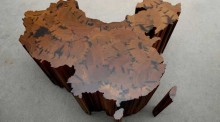By James D. Poborsa
Ai Weiwei 艾未未 is as much an activist as he is an artist – in recent years perhaps even more so. That this should be the case is by no means surprising, given his own historical relationship with the Chinese state, and the escalating degree of persecution he has faced at home – not primarily because of his art, but because of his activist politics and the extensive platform afforded to him internationally, as an innately politicized voice in a markedly depoliticized state.
Ai Weiwei is not simply an artist, but a critic and activist of the first order. On the role of the artist as intellectual, Ai has argued that with “artists and intellectuals today, what is most needed is to be clear about social responsibility, because that’s what most people automatically give up. Just to protect yourself as an individual is very political. You don’t have to march on Tiananmen, but you have to be clear-minded, to find your way of expression.” Many other artists currently working in China are exceptionally critical of the state, and of China’s tumultuous past, yet Ai’s work strikes a particularly poignant and also tremendously sensitive chord.
The Art Gallery of Ontario’s current exhibition of his work, According to What?, features numerous works spanning the artist’s career, from the 1980s until the present, with many works specifically highlighting his activist politics. Perhaps the most powerful and visually arresting of these is his installation Straight (2008–2012), a collation of thousands of steel rebars that have been painstakingly re-straightened in the wake of the devastating 7.9 magnitude earthquake which struck in Wenchuan, Sichuan province, on May 13, 2008. For Ai, the installation is a commentary upon government neglect – neglect that so many schools and buildings were not built to code, that there was no official investigation into why this was the case, and that none of the builders have ever been held accountable. Further, the work is in commemoration of those who lost their lives, over 5,000 of whom were children, and whose names are printed on the wall in the same exhibition hall. The callous indifference towards such gut-wrenching tragedy by many in power is rather bluntly criticized by the artist, who states that “the tragic reality of today is reflected in the true plight of our spiritual existence: we are spineless, and cannot stand straight.”
Another sculptural installation, River Crabs (2010), consists of hundreds of porcelain river crabs made in Jingdezhen 景德镇, and is a tripartite commentary on the official government policy of Hu Jintao 胡锦涛 and Wen Jiabao 温家宝, who promoted the building of a harmonious (hexie 和谐) society. The term “river crab” (hexie 河蟹) is a homonym for “harmonious,” and has become internet slang for censorship among Chinese netizens.
In recent months, and in support of social stability and the promotion of the government’s newly minted catchphrase The Chinese Dream (Zhongguo meng 中国梦), the CCP circulated a memo entitled Document 9, which is generally attributed to Xi Jinping 习近平, the current General Secretary of the CCP. Of the seven perils currently facing the PRC, “promoting ‘universal values’ of human rights” and “Western-inspired notions of media independence and civic participation” speak directly to the type of activist politics that have landed Ai in jail and under house arrest. Ai’s caustic remarks, his biting satire, and his trenchant perseverance amid relentless government persecution are what make his voice particularly resonant among international audiences. Dissecting the fascinating relationship between art and activist politics in modern China is no easy task, and rigorous scholarly attention to this topic has been scant to say the least.
On the evening of September 25, 2013, in an event at the AGO co-presented by the Asian Institute at the Munk School of Global Affairs, a panel of experts on contemporary Chinese art and cultural politics will assess Ai Weiwei’s position as a dissident artist, and the lingering effects of his iconoclastic brand of cultural production upon the contemporary Chinese art scene. For anyone with an interest in exploring the complex trajectories Ai Weiwei’s activist art, this is an event that surely shouldn’t be missed.
James Poborsa is a doctoral candidate in the Department of East Asian Studies and an Affiliate at the Asian Institute, Munk School of Global Affairs, University of Toronto.
Photo credit: Ai Weiwei, Map of China, 2008. Collection of the Faurschou Foundation. Image courtesy of the artist.
